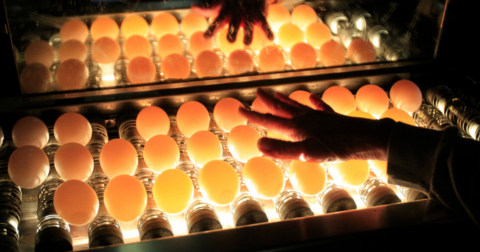News
Costco Chicken Processing Plant Keeps Failing Tests for Salmonella
Food•5 min read
Explainer
The shift from battery cages to cage-free farms, explained.


Words by Seth Millstein
There was a time when cage-free eggs were a rarity. Now, they comprise almost half of all chicken eggs produced in the U.S., according to a new report by the Open Wing Alliance. There are over 300 million laying hens in the U.S. at any given time, and the transition to cage-free systems marks a significant improvement to their welfare. But is it enough?
Since World War II, egg-laying hens have typically been raised in cramped cages without enough room to stand, turn around or spread their wings. But this has slowly been changing over the decades, with egg producers pledging to go cage-free and governments around the world requiring chicken farmers to implement cage-free facilities.
“Cage-free systems are a meaningful and important step forward for improving the welfare of egg-laying hens,” the Humane League, a founding member of the Open Wing Alliance, told Sentient in an emailed statement. “Cage-free environments allow hens to move, walk and perch — basic, natural behaviors that cages make physically impossible. These basic, natural behaviors are critical to a hen’s well-being and being free from caged confinement represents a significant improvement in quality of life for hundreds of millions of animals worldwide.”
Cage-free systems are undoubtedly better for chickens than battery cages. But are they really that much better?
It’s important to note at the outset that “cage-free” doesn’t have a strict legal definition. In the U.S., for instance, there are several entities that offer “cage-free” certification: The USDA (a branch of the government), Certified Humane (a non-profit) and United Egg Producers (an industry trade group). This is also true about two other welfare designations we’ll address later, “free-range” and “pasture-raised.”
According to the Open Wing Alliance report, 45.7 percent of U.S chicken eggs are now produced in cage-free facilities, up from 38.5 percent a year earlier. The long-term increase in cage-free facilities is even more striking: Back in 2012, less than ten percent of chicken eggs in the U.S. were cage-free.
Some of this progress is thanks to Proposition 12, a California law that bans the in-state production and sale of eggs that were produced using battery cages. Implemented in 2022, Proposition 12 has compelled many out-of-state farmers to adopt cage-free systems, as this gives them access to the lucrative California egg market.
Elsewhere in the world, Sweden’s chicken eggs are now 100 percent cage-free, according to the report. At least ninety-percent of eggs in Germany are produced in cage-free facilities, and thanks to a looming legal deadline, that number will rise to 100 percent by the end of 2028.
The cage-free movement is a response to, and an attempt to eliminate, the use of battery cages on poultry farms. These are small, wired enclosures in which millions of egg-laying hens are confined for their entire lives. Chickens in battery cages don’t have enough room to stretch, turn around or fully extend their wings — let alone walk, peck, perch or engage in other natural chicken behaviors.
This level of extreme confinement wreaks havoc on chickens’ bodies. They frequently develop osteoporosis, a painful weakening of their bones that often results in fractures. One 2004 study found that 89 percent of commercial egg-laying hens suffered from CLO, or Cage-Layer Osteoporosis; in a 2008 study, one-third of chickens studied experienced bone fractures after being removed from their cages before getting slaughtered.
Hens in battery cages suffer immensely, and it’s not only due to the lack of space. They’re often subjected to a practice known as forced molting, which involves starving them for weeks at a time so that they’ll lay eggs at a slightly faster rate once they’re fed again.
Battery cages are indoors, and the hens in them can experience no natural sunlight in their lifetimes. Instead, farmers will blast them with artificial lighting for up to 18 hours a day, as this “tricks” their bodies into producing more eggs than they otherwise would.
This biological manipulation takes a serious toll on hens’ bodies; because eggs are made from calcium, artificially increasing a hen’s egg output diverts calcium from her bones. This can lead to a condition known as Cage-Layer Fatigue (CLF), or a weakening of the bones so severe that the birds effectively become paralyzed, and can’t stand or move.
In addition to living in open spaces instead of cages, chickens on cage-free farms are given unlimited access to food and water, and provided with enough vertical and horizontal room to roam freely during their laying cycles.
Some certification organizations have additional requirements. The USDA requires cage-free chicken farms to provide their birds with enrichments, like scratching areas and perches, so that they can “exhibit natural behaviors,” while United Egg Producers specifies that each bird must have at least one square foot of space to themselves.
“Birds in general explore their environment by hunting and pecking, especially chickens,” Darrin Karcher, associate professor of animal sciences at Purdue University, tells Sentient. “And so giving them the ability to have that litter to manipulate helps them immensely.”
Despite these improvements, cage-free chicken farms can still be somewhat cramped; many cage-free facilities have thousands of chickens living in what’s essentially one large room, though it’s worth noting that chickens will sometimes huddle together for warmth even when given enough space to disperse. — Moreover, the chickens in them aren’t necessarily provided with natural light, outdoor access or the opportunity to engage in natural behavior like foraging and dust-bathing.
In addition, chickens on cage-free farms may still be subjected to a number of gruesome and painful procedures that are common for farmed chickens, such as beak-slicing and maceration of male chicks. The latter practice may soon be a thing of the past thanks to recent technological advances, but it’s still permitted on cage-free farms.
These limitations mean that, from an animal welfare standpoint, the most bare-bones cage-free facilities are still a long way from ideal. But their impact shouldn’t be downplayed: According to one study, a hen raised in a cage-free environment instead of a battery cage will be spared around 7,000 hours of pain.
“We moved from the conventional cage to cage-free because of the increased ability for those birds to move,” Karcher says, and “better welfare outcomes.” Considering the range of ways to farm eggs, Karcher adds, “when we move from cage-free, the next natural progression then would be to your pasture poultry, or outdoor access.”
Transitioning from a battery cage system to a cage-free farm is a costly investment for farmers.
“Movement from conventional cage to cage-free — and it doesn’t matter what type of cage free system they put in — will be more costly than the conventional cage system to install,” Karcher says.
Construction is the first challenge. Cage-free farms use different infrastructure than battery cages, and require some additional features, like scratching areas and litter. In some cases, farmers can simply rip out the cages of their existing buildings and construct cage-free facilities inside, but depending on the nature of the building, this may not be an option.
“We have some buildings where they just are not capable of making those retrofits, so they will actually go in and have to build new construction,” Karcher says. “The challenge is, with new construction, you may run into permitting. You may run into other issues.”
Once they’re built, cage-free farms also require more management and oversight than caged systems. Farmers need to monitor the behavior and interactions of the birds, the state of the litter they’re provided with, and in general, “be more in tune with the actual birds and that environment” than in caged systems, says Karcher. This, too, requires additional investments in labor and training.
All of this money effectively raises the cost of producing eggs, which begs the question: Are cage-free eggs more expensive?
There’s no question that cage-free systems are more expensive and less economically-efficient than caged systems, as they result in fewer eggs per square foot of farm. This means that producers have to charge more for cage-free eggs to make a profit; exactly how much more, though, has been the subject of debate.
Over the last few years, egg prices in the U.S. have skyrocketed. This is largely due to two factors: avian flu, which arrived in the U.S. in 2022 and has devastated chicken flocks nationwide; and general inflation, which has increased the price of all goods nationwide.
Both avian flu and inflation hit the U.S. around the same time that Proposition 12 went into effect in California, which has led some, including the Trump administration, to blame the law’s new requirements for high egg prices. However, a Purdue University study conducted in 2023 found that Proposition 12 has only increased the cost of eggs in California by 25 and 73 cents per dozen for consumers, only accounting for a small fraction of the increase in egg prices over the last few years.
In addition to “cage-free,” egg cartons often have labels like “free-range” or “pasture-raised.” These terms aren’t strictly defined either, and can differ depending on the certification organization and farm in question.
Broadly speaking, free-range chickens are supposed to have access to the outdoors in addition to all of the space, food and water access they’d get in a cage-free system.
The specifics again differ from one certifying organization to another. In order to be certified free-range by the USDA, hens must be given continuous access to the outdoors, while Certified Humane only requires that they have six hours of outdoor access per day. Certified Humane mandates at least two square feet of space per bird on free-range farms; by contrast, American Humane Certified free-range hens are given 21.8 square feet of space per bird.
In theory, pasture-raised hens are given more space and freedom than cage-free or free-range. But the term “pasture-raised” is also the least regulated of the three, as it’s not recognized or certified by the USDA. As such, there’s nothing preventing any egg producer from slapping a “pasture-raised” label on their cartons, regardless of how the hens were actually raised.
However, several private organizations offer pasture-raised certification, and their standards are quite high. Certified Humane and American Humane Certified both require that pasture-raised hens be given 108 square feet of space each, while Certified Humane additionally requires that the fields on which the hens roam be rotated throughout the year.
Cage-free, free-range and pasture-raised facilities are all attempts to improve the well-being of farmed birds. But our understanding of animal welfare is constantly evolving, and Karcher says that contemporary studies into birds’ emotional states may soon offer opportunities to improve their lives even more.
“We can start moving into new areas where not only are we worried about the welfare of the birds, but we better want to understand: Are they happy?,” Karcher says. “Are they sad? And we can’t do that at this point. We may never get to that point. But that is what behavior and welfare science is really starting to emphasize more in the research.”
The life of a cage-free chicken is still a far cry from the natural freedom they’d experience outside of a farm, but it’s still a welfare improvement from the cramped confines of battery cages. Surveys and sales data both show that customers want cruelty-free eggs, and the growing adoption of cage-free facilities by egg producers shows that progress on this front, though slow, is still possible.